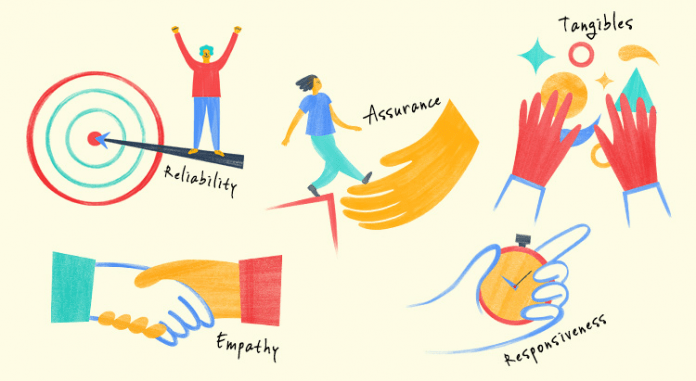The Gap Model of Service Quality
The diagram below shows a visual representation of the Gap Model of Service Quality.

To use the model, an organization should measure each of these gaps and then take steps to manage and minimize each gap. Let’s examine each of the five gaps in turn.
Gap 1: Knowledge Gap
The knowledge gap is the difference between the customer’s expectations of the service and the company’s provision of that service. Essentially, this gap arises because management doesn’t know exactly what customers expect. There are a number of reasons this could happen, including:
- Lack of management and customer interaction.
- Lack of communication between service employees and management.
- Insufficient market research.
- Insufficient relationship focus.
- Failure to listen to customer complaints.
Example:
If Netflix were to suffer from this gap then it could be because they don’t offer the right amount of newer titles to their customer. If Pizzahut were to suffer from this gap then it could be because they don’t offer pecan pie. In both cases, customers expect these things but they simply aren’t offered.
Gap 2: The Policy Gap
The policy gap is the difference between management’s understanding of the customer needs and the translation of that understanding into service delivery policies and standards. There are a number of reasons why this gap can occur:
- Lack of customer service standards.
- Poorly defined service levels.
- Failure to regularly update service level standards.
Example:
If Netflix were to suffer from this gap then it could be that they offer all the right shows but the streaming quality level isn’t high enough. If Pizzahut were to suffer from this gap then it could be they offer pecan pie but the quality isn’t as good as people expect. This gap causes customers to seek a similar service elsewhere but with better service.
Gap 3: The Delivery Gap
The delivery gap is the difference between service delivery policies and standards and the actual delivery of the service. This gap can occur for a number of reasons:
- Deficiencies in human resources policies.
- Failure to match supply to demand.
- Employee lack of knowledge of the product.
- Lack of cohesive teamwork to deliver the product or service.
Example:
If Netflix were to suffer from this gap then it could be because when the customer selects the show they want to watch it takes five minutes before it starts to play. In this case, the product isn’t performing as it should.If Pizzahut were to suffer from this gap then it could be that when the customer orders the pecan pie they are informed that the kitchen has run out. In this case, supply hasn’t been adequately matched to demand.
Gap 4: The Communication Gap
The communication gap is the gap between what gets promised to customers through advertising and what gets delivered. Again. there are a number of reasons why this can happen:
- Overpromising.
- Viewing external communications as separate to what’s going on internally.
- Insufficient communications between the operations and advertising teams.
Communication gaps lead to customer dissatisfaction. This happens because what they receive isn’t what they were promised. In the worst case, it may cause them to turn to an alternative supplier.
Example:
If Netflix were to experience this gap then it could be because that although the service is good it isn’t as good or as easy to use as depicted in the advert. If Pizzahut were to suffer from this gap then it could be because the pecan pie was good but it wasn’t as large or delicious as it looked in the advert.
Gap 5: The Customer Gap
The customer gap is the difference between customer expectations and customer perceptions. This gap occurs because customers do not always understand what the service has done for them or they misinterpret the service quality. Many organizations can be completely blind to this gap. This gap can happen because of one of the other four gaps, or simply because the customer perceives the quality of the service incorrectly. In a worst-case scenario, it could lead to a business losing a large proportion of their customers overnight. Although the company thought there was no gap, the reality was that their customers were just waiting for someone to fill their perceived gap.
Important
According to the Gap Model of Service Quality, the only way to close the customer gap is to close the other 4 gaps in the model. The extent to which one or more of these four gaps exist will determine the extent to which customer perceived quality falls short of their expectation.There is no way for the company to directly close this gap.


